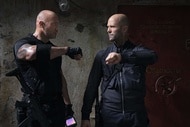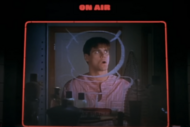Create a free profile to get unlimited access to exclusive videos, sweepstakes, and more!
Celebrate Tobe Hooper's birthday with the under-appreciated mayhem of 'Eaten Alive' on Peacock
Tobe Hooper's follow-up to The Texas Chain Saw Massacre is just as insane as its predecessor.

Tobe Hooper, the Texas filmmaker who became a horror icon thanks to The Texas Chain Saw Massacre in 1974, would have turned 80 today, and I'm sure horror fans are celebrating in any number of ways. For some, it means watching Chain Saw for the thousandth time. For others, it means looking back on his Masters of Horror contributions or his work with John Carpenter on Body Bags.
These are all benchmarks in a fascinating horror career, one that saw many highs and direct-to-video lows for Hooper, who never reached the household name status of peers like Carpenter and Wes Craven, but also never gave up on his own wild, scary movie style. Because Hooper isn't quite as well-known — and because he worked on such a range of horror pictures across five decades — there are several under-appreciated gems to choose from if you're looking to celebrate a lesser-known effort from the mind behind Texas Chain Saw. So, which one should you watch?
Well, if you're looking for more Texas mayhem in a new setting, it's time to open up Peacock and press play on Eaten Alive.
Made two years after Chain Saw and co-written by that film's co-creator, Kim Henkel, Eaten Alive is another Texas-based horror from Hooper that's in some ways transparently similar to its predecessor; it's got a rundown backwoods house, a malevolent and sexually frustrated killer who wields farm implements, and even a chase scene through the woods at night. But it's far from a carbon copy. Instead the film emerges as Texas Chain Saw's demented cousin from the swamps, resulting in a surreal atmosphere of madness that contrasts with Hooper's from-the-hip horror classic.
The killer at the heart of Eaten Alive is Judd (Neville Brand), a strange, lonely man who runs a backwoods hotel next door to a swamp where he happens to keep a pet alligator fed through often unsavory means. The film is — like Texas Chain Saw — a straightforward tale of various people being lured into Judd's clutches and then killed in various ways until someone manages to fight back. While this premise isn't as well-crafted as Chain Saw with its docudrama-style photography and sense of earthy, sweaty realism, that's not why you come to Eaten Alive. Instead, you come to Eaten Alive for its deep strangeness, and the sense of a descent into something not unlike a fantasy nightmare.
Hooper achieves this distinction, in part, by setting the film in East Texas (we're told early on that the hotel is about an hour's drive from Tyler, if you want to look at a map), which sports a different flavor than the Austin-adjacent country where Chain Saw was filmed. Heightened though it is, the swamp in Eaten Alive does convey something of the transportive power of the East Texas wilderness, whether we're talking about the bayous or the piney woods. If you've ever driven around out there, there's the sense that you really could just disappear around a corner and find something completely removed from civilization, not just in terms of communication but in the sheer aura. Hooper uses that vibe to his advantage, then dials it up as far as he possibly can.
To add to the sense of getting lost — even trapped — in Judd's violent world, Eaten Alive was filmed on sound stages, further contrasting it with Texas Chain Saw's on-location photography. Yes, this meant Hooper had to deal with a certain amount of artifice, but it's artifice that works; the soundstage meant the director could pack the film with strange, gel-infused lighting, painting huge portions of the screen bright crimson-red or eerie pinkish-purple. The soundstage also means the woods around Judd's property have an almost Wizard of Oz feel to them, like they're not quite there, like you could step into them and simply disappear. So instead, you're stuck trying to fight your way out of this murder hotel, adding to the sense of madness that infuses the film with unease.
RELATED: The 12 scariest horror movies streaming on Peacock, from 'Sick' to 'Sinister'
That unease and madness is further heightened — and indeed perfected — by Brand's terrifying lead performance as Judd. Because Hooper has surrounded the actor so completely with a sense of nightmarish artifice, amped up by the perpetual drawl of country radio and the arrival of guests with some issues of their own, it falls to Brand to make the hotel and everything in and around it feel like his demented kingdom. He rises to that challenge with a truly upsetting, unnerving performance, one that fits right into the landscape yet also seems to float somewhere above it, as though Brand is living in a completely different movie.
While it never reaches the heights of Hooper at his best — and indeed, some of the more surreal horror elements would be perfected years later in the The Texas Chainsaw Massacre 2 — Eaten Alive remains one of the director's most fascinating works. It's a wild ride packed with memorable moments of unhinged Hooper invention, and a great way to celebrate the 80th birthday of one of our most important horror filmmakers.
Eaten Alive is now streaming on Peacock.


























